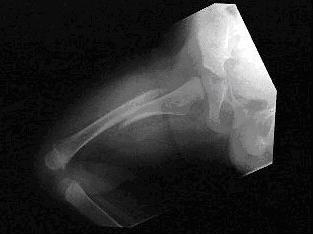If you’re preparing for the United States Medical Licensing Examination® (USMLE®) Step 2 exam, you might want to know which questions are most often missed by test-prep takers. Check out this example from Kaplan Medical, and read an expert explanation of the answer. Also check out all posts in this series.
This month’s stumper
A 2-year-old boy is brought to the emergency room by his parents because of limping. His parents report that he was well until yesterday, when he fell in the bathtub. Since then, he has been limping and refusing to bear weight on his right leg. A radiograph of the right femur shows a displaced transverse fracture of the shaft of the femur without soft tissue changes. The child's leg is immobilized and stabilized. Complete blood count and coagulation studies are within normal limits.
Which of the following is the most appropriate initial step in management?
A. Application of traction.
B. Obtain a genetics consult for osteogenesis imperfecta.
C. Obtain a skeletal survey.
D. Perform closed reduction and external fixation.
E. Perform open reduction and internal fixation.
F. Placement of a spica cast.
The correct answer is C.
Kaplan Medical explains why
This patient has sustained a closed fracture of the femur shaft with no apparent bleeding into the thigh. Femoral shaft fractures result from high-energy trauma. In young children, one must always consider the possibility of abuse because approximately 70% of femur fractures are nonaccidental (i.e., inflicted). The patient is stable and immobilized and, at this point in management, requires a skeletal survey to identify other possible fractures and evaluate for potential abuse.
Why the other answers are wrong
Choice A, D and F: Application of traction, closed reduction and external fixation, and the placement of a spica cast are all ways of managing a fracture sustained in the femur. However, these constitute definitive management. The initial management is to complete a secondary survey and identify all possible injuries in the child with a high risk for abuse.
Choice B: Obtaining a genetics consult for osteogenesis imperfecta is incorrect for the initial step of management. Osteogenesis imperfecta is a rare cause of pathologic fractures in children. Diagnosis requires extensive testing, and referral to a genetics consult would not constitute appropriate initial management before more common causes of femoral shaft fractures are evaluated.
Choice E: Open reduction and internal fixation is performed in displaced epiphyseal fractures, in neurovascular injuries requiring repair, in open fractures of the femur and tibia, and following a failed attempt to obtain anatomic alignment. This child's presentation is not an indication for surgery. Therefore, the most important initial step is to identify all injuries before definitive management.
Tips to remember
- Almost half of the infants and young children who present with a fracture of the femur are believed to be victims of child abuse.
- The best next step in a stable child with a femur fracture is to perform a skeletal survey to look for other possible fractures and evaluate for potential child abuse.
For more prep questions on USMLE Steps 1, 2 and 3, view other posts in this series.
The AMA and Kaplan have teamed up to support you in reaching your goal of passing the USMLE® or COMLEX-USA®. If you're looking for additional resources, Kaplan provides free access to tools for pre-clinical studies, including Kaplan’s Lecture Notes series, Integrated Vignettes, Shelf Prep and more.




